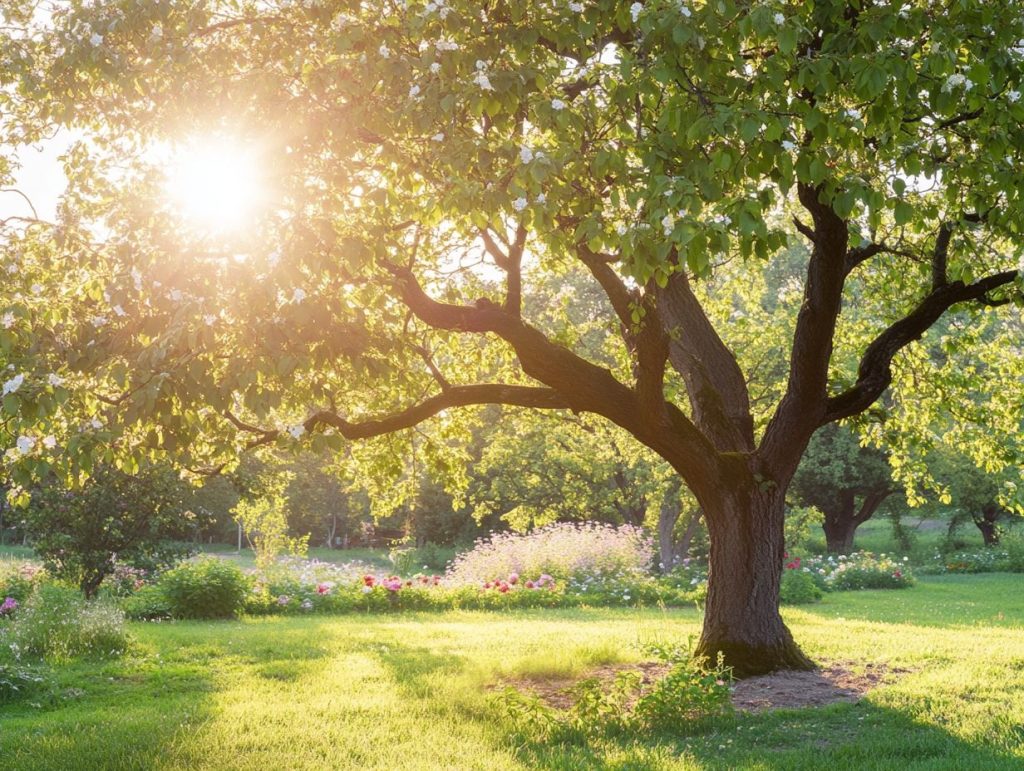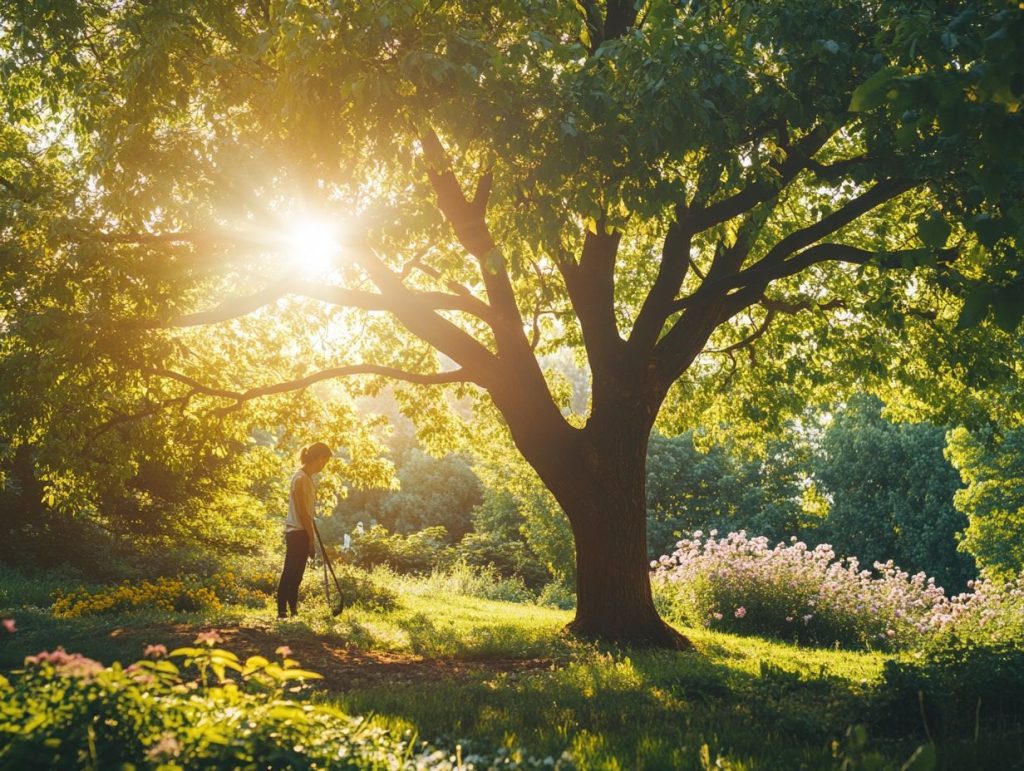Trees are more than just a beautiful addition to your property; they play a vital role in our environment, providing shade, improving air quality, and enhancing biodiversity. Maintaining their health goes beyond occasional trimming. This article explores the importance of tree maintenance, common trimming mistakes to avoid, and the crucial differences between pruning and trimming. Learn how to identify potential issues, discover expert care techniques, and understand why hiring a professional service can be a smart investment.
Your trees deserve the best care; this guide will help them thrive for years.

The Importance of Tree Maintenance
Maintaining trees is crucial for their health and the overall well-being of your environment and community. Tree maintenance includes several practices promoting tree health, longevity, and beauty, enhancing the ecosystem benefits you enjoy.
Caring for your trees can boost your property value, improve air quality, and support biodiversity, all of which help create healthier urban landscapes. By investing in tree services and consulting with a professional arborist, you play an important role in sustainability efforts that aim to preserve green spaces for future generations.
These practices ensure your trees thrive and promote the environmental stewardship we all need in today’s world.
Benefits for the Environment and Property
The benefits of regular tree maintenance go far beyond just looking good; they make a real difference for both the environment and your property value. When you have healthy trees around, you’re not just enhancing your landscape, you’re also providing habitats for wildlife and improving air quality by aiding carbon sequestration. Investing in tree services can boost your property’s value while creating a welcoming atmosphere.
Take a look at cities that focus on urban forestry programmes. You’ll often find their bird populations and pollinators thriving, which is essential for maintaining the ecological balance. Additionally, the air quality receives a nice upgrade since trees filter out pollutants and produce oxygen, making your neighbourhood healthier.
Successful programmes, like those in Portland, Oregon, beautify the community and bring people together for planting days, fostering a sense of responsibility for their local environment. These initiatives highlight how tree health and community well-being are interconnected, showing that when you take care of these valuable resources, they can thrive for future generations.

Common Tree Trimming Mistakes
Tree trimming is crucial for keeping your trees healthy and well-structured, but you can easily fall into common mistakes that could seriously affect their longevity and overall health.
Many overlook the importance of proper trimming techniques, leading to tree diseases or structural issues. Neglecting to remove dead branches when they should or trimming at the wrong time of year can damage your trees’ growth and health.
That’s why consulting with a professional arborist is a sensible move; it helps you avoid these pitfalls and keeps your trees healthy and resilient.
Impact on Tree Health and Growth
Improper tree trimming can seriously affect your tree’s health and growth, potentially leading to diseases or even the unfortunate demise of your beloved trees. When you cut branches the wrong way, you disrupt the tree’s natural structure, making it harder for it to thrive. This can impact everything from root health to how well the foliage develops, ultimately affecting the tree’s overall vitality. Regular assessments by a professional can help you spot potential problems before they escalate, ensuring your trees stay strong and vibrant.
You really can’t underestimate the importance of using proper trimming methods—especially when it comes to crown shaping, which is vital for encouraging healthy growth. By keeping the tree’s structure intact, you allow for optimal light penetration and air circulation, both of which are essential for robust foliage and fruit production.
Proactive monitoring of your tree’s growth is crucial. Whether through simple visual inspections or bringing in an arborist, catching changes in tree health early can make a significant difference. Plus, adhering to safe trimming practices—such as knowing the right timing and techniques—and keeping an eye out for disease symptoms, such as discoloured leaves or unusual growth patterns, will help promote longevity and resilience in your trees.
Pruning vs. Trimming: What’s the Difference?
Understanding the difference between tree pruning and trimming is vital to keeping trees healthy and encouraging proper growth. While both practices aim to make your trees look great, their methods and purposes differ.
Trimming is usually about tidying up by removing excess leaves and maintaining the tree’s shape. On the other hand, pruning is a more strategic move where you target specific branches to promote healthier growth and improve the tree’s overall structure.
Knowing when to use each technique, especially during the proper seasonal care periods, will help your trees thrive.
When to Prune vs. Trim
Knowing when to prune or trim your trees is crucial for their health and appearance, so timing matters in tree maintenance. You typically want to do your pruning during the dormant seasons; this way, your trees can heal better and receive a nice growth boost come spring.
On the other hand, trimming can occur throughout the year, depending on the specific needs of your tree species and their health. It’s a good idea to consult a professional arborist to gain insights on these timing nuances, ensuring your trees receive the care they need tailored to your unique landscape.
For example, flowering trees like dogwoods and azaleas should be pruned right after they bloom. This way, you won’t accidentally cut off their future blossoms. Deciduous trees, however, can often be pruned in late winter. Evergreens don’t require frequent pruning, but they might need some trimming to maintain their shape and health during the growing season.
Each species has its requirements, and an expert can help assess the health and growth patterns of the trees in your garden.
By scheduling regular assessments, you can create a maintenance plan that enhances your trees’ aesthetic appeal and promotes their longevity and resilience.
Signs Your Trees Need More Than a Trim
It is essential to recognise the signs that your trees need more than a simple trim. Catching these early can help prevent further damage and promote their long-term health.
Keep an eye out for symptoms like wilting leaves, discoloured bark, or a noticeable drop in foliage—these could be red flags pointing to underlying issues like tree diseases or pest infestations.
Conducting a thorough assessment of your trees, preferably with the help of a professional arborist, can give you valuable insights into their condition and help you determine if tree removal or some extra care is necessary.
Identifying Potential Tree Issues
Identifying potential tree issues early helps keep trees healthy and avoid costly interventions. Look for signs of distress, such as unusual growth patterns, thinning foliage, or any visible pests. Conducting a thorough tree assessment and regular foliage inspections helps you spot areas that need attention, such as root health and crown structure. By tackling these issues promptly, you can encourage healthier trees and boost the resilience of your landscape.
Regular monitoring is key to maintaining tree vitality because subtle changes can signal underlying problems. Look for leaf discolouration, bark anomalies, or even fungi—these are critical indicators you shouldn’t ignore.
Building a relationship with a qualified arborist can pay off. These professionals have the expertise to conduct comprehensive evaluations and can guide you through effective management strategies. They can help you spot the apparent issues and those sneaky, less visible conditions, ensuring your trees receive the best care possible. By taking these proactive steps, you’ll create a thriving environment for your trees.
Proper Tree Care Techniques
Proper tree care techniques are essential for keeping trees healthy and helping them thrive in their environment. Effective tree care includes regular watering, enhancing the soil, and mulching to boost soil quality and retain moisture.
You will also want to focus on proper fertilisation and improving drainage, as these can significantly improve your trees’ overall health and growth. If you are unsure where to start, consulting with a professional arborist can provide tailored strategies that perfectly fit your specific tree species and local conditions.
Expert Tips for Maintaining Healthy Trees
Following expert tips can work wonders to keep your trees healthy and thriving, ensuring they stay vibrant and resilient for years. Start by getting to know your tree species and their specific needs; this foundational knowledge is crucial for effective tree care.
Make it a habit to inspect your trees regularly for signs of pests or diseases, and remember to engage in seasonal practices like proper pruning and mulching. Consulting a professional arborist can give you invaluable insights and tailored advice to optimise your tree maintenance efforts and promote biodiversity if you want to up your game.
This approach not only boosts the overall health of your trees but also contributes to a thriving ecosystem in your landscape. Every tree species has unique characteristics—think growth patterns, water needs, and vulnerability to local pests—so getting familiar with these traits is key to successful tree management.
Regular inspections can help spot potential issues early, allowing for timely intervention. Plus, professional arborists come equipped with the expertise and specialised knowledge that can ensure your care techniques are effective and sustainable, leading to a healthier garden and a better community overall.
Hiring a Professional Tree Service
An investment that can do wonders for your garden and your trees’ health. When you bring in a qualified arborist, you get someone who knows the ins and outs of tree care, from health assessments to risk evaluations. This expertise helps you make informed decisions that align perfectly with your gardening goals.
Professional tree services can tackle a wide range of needs, whether tree removal, maintenance, or pest control, ensuring your trees receive the TLC they need to thrive. Plus, many tree services offer tree insurance options, giving you peace of mind and adding extra protection for your investment.
Why It’s Worth the Investment
Investing in professional tree services isn’t just about keeping your trees healthy; it’s also a wise move to boost your property value and enrich community green spaces. When your trees are well-maintained, they do wonders for the environment by improving air quality and supporting biodiversity, making your property much more attractive to potential buyers.
A professional arborist can ensure that your trees thrive for years, which is a long-term investment in your landscape’s appearance and function. The benefits of professional tree care extend beyond the immediate advantages, positively impacting your property and the community around you.
Well-kept trees can increase the market value of your home by as much as 15% in certain areas. That demonstrates how essential tree services are for homeowners like you. Moreover, a manicured landscape can boost neighbourhood pride and encourage community engagement, creating a sense of place and belonging.
When you invest in experienced tree care, you end up with healthier canopies that provide shade, lower energy costs, and offer habitats for local wildlife.
Regular tree maintenance enhances the appearance of your property and reduces potential hazards, making your streets safer and parks more inviting. Therefore, the impact of such investments ripples through the community, enhancing environmental quality and promoting long-term sustainability.